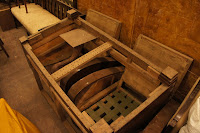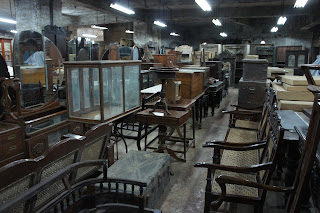Hello fellow antique lovers. Here is my guide to shopping for antique and colonial furniture in Mumbai, written for April edition of Chalo! Magazine.

Chor Bazaar
Before
I moved to Mumbai and my husband was left here on his own hunting for an
apartment, I envisaged that we would end up in a dreamy colonial bungalow
filled to the rafters with elegant furniture – plantation chairs, four poster
beds draped with muslin wafting in the breeze and a study furnished with a fine Art Deco desk and one of those huge globes that would double as a drinks
cabinet.
Well
it didn’t quite work out like that as we now occupy a modern 11th
floor apartment with magnolia walls and cream tiled floors – and a heap of
disgusting laminate furniture put there by our landlady. Don’t get me wrong – I love our abode with
its sea views and sunlight flooding through the sliding doors - but the place in
no way fulfills my romantic notions!
No
matter. Since moving in, I have been gradually moving out the offensive items
(which included a revolting black vinyl three piece suite), replacing each one with
our solid wood finds. I have a
particular passion for antique colonial furniture (even before I left the UK)
and so we spend many a weekend hunting down suitable pieces. Furnishings that will not only fit our modern
Bandra apartment but that will also suit our future home in the UK. So I will now share with you my favourite
places to shop.
Note:
I like a bargain. Some places in Mumbai
(which I will still mention here), charge the earth so I will therefore focus
on ‘good value’ and the ‘thrill of the hunt’.
 |
| Camelot - the shop itself is a dreamy colonial bungalow |
Top
of the list has to be Camelot in
Kemps Corner. The Camelot shop is a
beautiful colonial villa worth a visit in its own right and I like the elegant,
unfussy style of the place. There are two large rooms filled with genuine
colonial antiques including armoires, huge plantation chairs, art deco desks,
mirrors and the occasional artwork. I
have picked up a couple of side tables here for around 6,000-8,000 Rs
each. The prices are extremely
realistic and the quality is good – each piece is handpicked. The armoires and mirrored cupboards are in
the 20,000 Rs range. Unfortunately, the place was outed after I wrote about it
on my blog, and every time I go back the stock is relatively low but there is
still enough to create interest.
 |
| Above and below: our Chor Bazaar find - before and after |
Antique
shopping cannot be mentioned without touching on good old Chor Bazaar. I could spend
hours on Mutton Street, sifting through trinkets and Bollywood Posters and
going up and down the many narrow shops bulging with dusty furniture. You have
to be able to haggle though. We found a
beautiful rosewood Indo-Portuguese chair for 18,000 Rs (the dealer started at
30,000 Rs but we still may have paid over the odds for that one) and a basic
art deco wooden chair for only 4,000 Rs. The latter was reproduction and you
will have to look very closely if you want the genuine article. Personally, I’m not that fussed providing the
look is right and the item is teak or rosewood. We also purchased a whole art
deco sofa suite for about 40,000 Rs. When we discovered it in a filthy old
attic of one of the showrooms, it was a complete wreck. But with the help of the
dealer’s restorers, it was easily brought back to life with a fine polish and
new upholstery - all included in the above price. (I haven’t mentioned any specific dealers
here – there are so many you just need to hunt around, comparing prices from
shop to shop).

Oshiwara Furniture Market in Jogeshwari is
similar to Chor Bazaar in concept. But it’s
not as much fun. I find the antique
dealers a bit surly and not so ‘up’ for haggling. And you will need plenty of
energy and mosquito spray whilst you repeatedly tread up and down the many
(very) narrow shops. A lot of the stuff
is repro (especially the art deco pieces) but any purchases can still go
towards creating that beautiful colonial look.
We have picked up teak art deco style occasional tables for 4,000 Rs. If
you enjoy the hunt, you will certainly enjoy Oshiwara.
 |
| The Great Eastern Home - every corner filled with top quality furniture with prices to match. |
For
sheer designer class with huge prices to match, you want to visit The Great Eastern Home. Set in an
enormous mill complex, the many showrooms are spread over a very large area -
all beautifully dressed and stocked. I
find the place a bit daunting and there is always someone following you and
rushing to switch on the fans as you go from room to room. But there is no doubting the quality of the inventory. Coffee tables, mirrors and small chests are
going to set you back tens of thousands of rupees and the larger pieces…well I
haven’t bothered to enquire! Definitely
worth a look if you have the budget and want to do a ‘one stop shop’.
 |
| The Raj Company: the ground floor has all the original antiques |
Similarly
high prices and quality can be found at the The Raj Company. Opposite
Mahalaxmi racecourse is a large building where you can wonder around
unhindered. The ground floor contains
all the genuine antiques – mostly in an unrestored state, which you can then
have brought back to life using their team of craftsmen. I enquired about an art deco suite and they
quoted 1 lakh to restore, upholster and deliver – so about 100% more than the
suite we purchased in Chor Bazaar. On
the floor above is a warren of rooms displaying beautiful reproduction campaign
chests, wardrobes, beds, dining sets and much more. All top quality stuff with prices to match.
The
famed Philips Antiques in Colaba
sells mostly artefacts, engravings and other easily transportable items for
tourists. What you may not know, is that
they also have a huge warehouse in Wadala East which
showcases very nice antique colonial furniture that has all been beautifully
restored. Their art deco pieces (my
particular passion as you may have guessed) are to die for. Again, the prices are pretty toppy (tens of
thousands of rupees upwards), but if you want something with a reassuring
provenance, then this is the place to come.
 |
| Moorthy's - filled to the rafters |
Moorthy's in Tardeo is a recent discovery - a large warehouse tucked away up a narrow lane filled to the rafters with the most beautiful finds. You will need at least an hour for a proper browse as everything is stacked high and some of it well hidden. If you have a particular requirement, Mr or Mrs Moorthy will assist you in finding and adapting a particular piece. For example, a 200 year old Gujurati cradle that we had converted into a coffee table. Prices are on the steep side but you can be assured that your purchase will come with a good story or history.
Fancy
something a bit more bespoke or made to measure? Try Colonial
Collections in Fort. The shop is
quite small so there are only a few examples of furniture on display (including
elegant sofas for around 1 lakh). But
rifle through the many brochures and you may well find exactly what you want –
they will re-create it for you using their team of skilled carpenters. I was quoted 45,000 Rs for a 40 inch square,
solid teak coffee table with glass top. They
seem to favour the unfussy style of US brand Stickley.
Lastly,
I want to mention the well-hidden Anemos
in Raghuvanshi Mills, which is very near your beloved Goodearth. Anemos is actually a shop retailing high
quality ceiling fans (it’s on the row of units on the left, before you turn
right into Goodearth. But if you go in
and ask to look at the antiques, they will take you to a large showroom
upstairs that is not visible from the street – filled with the most glorious
selection of Indian and colonial antiques and art work. I love the staff here – so friendly, helpful
and unobtrusive. The pieces are all very
nice quality with some unusual items thrown in such as the book-shelves that
fold up in different ways and the hexagonal, sectioned side tables. My husband and I have recently eyed up a
gorgeous teak drinks cabinet for about 45,000 Rs. They will also give you a discount if you ask
nicely.
There
are many other hidden places in Mumbai where you can hunt down antiques but I
need to do much more research on that…perhaps I will do a Part 2 some day!
DIRECTORY
Anemos
Krishna House, Gr. Flr.,
Raghuvanshi Estate,
Senapati Bapat Marg,
Camelot
127 Kemps Corner
Next to Om Chambers
Mumbai
Tel: 91 (22) 2364 4594
Next to Om Chambers
Mumbai
Tel: 91 (22) 2364 4594
Chor Bazaar
The
main hub is Mutton Street
(Note
closed Fridays for a general market)
Colonial Collections
Trafford
House
Moorthy's
5/1, Survodava Mills Compound
136, Tardeo Road
Mumbai 400 036
Oshiwara Furniture
Market
Ramjanak
Singh Compound
Oshiwara
Bridge, SV Road
Jogeshwari
(W)
Philips Antiques
Warehouse No. 13,
Western India Steel Traders Compound, 1803, Fort
Road,
Next to Godrej Vegetable Oil Mills, Wadala (East)
www.phillipsantiques.com
Next to Godrej Vegetable Oil Mills, Wadala (East)
www.phillipsantiques.com
The Great Eastern Home
The New Great Eastern Mills
25-29, Dr. Ambedkar Rd (Near Rani Baug)
Byculla
The Raj Company
Volga House , 1 - C, K. Khadye Marg,
Opp. Race Course, Mahalaxmi,
Volga House , 1 - C, K. Khadye Marg,
Opp. Race Course, Mahalaxmi,


















































